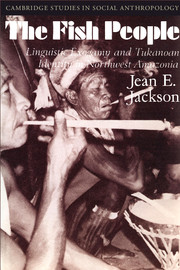Book contents
- Frontmatter
- Contents
- List of figures, maps, and tables
- Preface
- Acknowledgments
- Note on orthography
- 1 Purpose and organization of the book
- 2 Introduction to the Central Northwest Amazon
- 3 The longhouse
- 4 Economic and political life
- 5 Vaupés social structure
- 6 Kinship
- 7 Marriage
- 8 Tukanoans and Makú
- 9 The role of language and speech in Tukanoan identity
- 10 Male and female identity
- 11 Tukanoans' place in the cosmos
- 12 Tukanoans and the outside world
- 13 Conclusions: themes in Tukanoan social identity
- Notes
- Glossary
- References
- Index
- CAMBRIDGE STUDIES IN SOCIAL ANTHROPOLOGY
11 - Tukanoans' place in the cosmos
Published online by Cambridge University Press: 05 June 2012
- Frontmatter
- Contents
- List of figures, maps, and tables
- Preface
- Acknowledgments
- Note on orthography
- 1 Purpose and organization of the book
- 2 Introduction to the Central Northwest Amazon
- 3 The longhouse
- 4 Economic and political life
- 5 Vaupés social structure
- 6 Kinship
- 7 Marriage
- 8 Tukanoans and Makú
- 9 The role of language and speech in Tukanoan identity
- 10 Male and female identity
- 11 Tukanoans' place in the cosmos
- 12 Tukanoans and the outside world
- 13 Conclusions: themes in Tukanoan social identity
- Notes
- Glossary
- References
- Index
- CAMBRIDGE STUDIES IN SOCIAL ANTHROPOLOGY
Summary
Shamanism
The shaman is an extremely important figure in traditional Tukanoan culture. As is the case with other specialists in Vaupés society, this position does not relieve him of the normal duties and obligations of an adult man. The shaman is the one who “sees” and understands the relations between his community and the world it inhabits. He interprets and explains this relationship to others, and thereby warns and prescribes. He diagnoses and cures and above all protects by knowing how to maintain harmony and balance between his community and the rest of the universe. Part of this task of protecting the individuals under his care may involve bringing illness or misfortune to others, but good shamans never practice sorcery against people of their own community. Protection involves performing necessary rituals, prescribing correct food restrictions, making divinations, and “seeing” by going into trances. His activities help to ensure fertility of food sources and human fertility. He officiates at all transformations. He ushers newborn babies into the world of humans with water and food rituals and establishes their identities as members of particular language groups by giving them names, and through this, the “soul-stuff” which is passed along patrilineal lines (see C. Hugh-Jones, n.d., p. 9). He officiates at initiations for young men when they are first introduced to the Yuruparí, other ritual substances, and sacred knowledge, and at the menarche rituals for young girls.
- Type
- Chapter
- Information
- The Fish PeopleLinguistic Exogamy and Tukanoan Identity in Northwest Amazonia, pp. 195 - 210Publisher: Cambridge University PressPrint publication year: 1983



